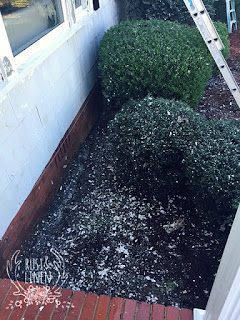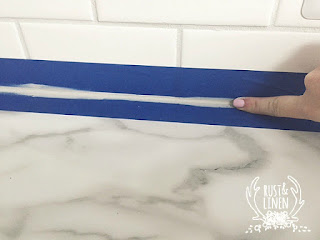As for this year, a few spotlights and wreaths will have to do for the exterior Christmas decor! :)
Friday, December 25, 2015
Exterior at Christmas
As for this year, a few spotlights and wreaths will have to do for the exterior Christmas decor! :)
Sunday, November 22, 2015
Exterior paint progress
WOW...it's been a while since I have last written anything. That doesn't mean that nothing has happened since July. It's actually the opposite! After I posted our infertility journey of 4 years (here) back in May, Drew and I have found out we are pregnant! I have a TON to post such as our gender reveal party when we found out it is a little girl! Ada Morgan Donaldson will be here April 28(ish), 2016. We are so excited and overwhelmed! Needless to say, that means I have to get the renovation in gear and finished.
Finally, I bit the bullet and hired a painter. Ya'll all know how much I hate to spend money on things that I feel like I can do. Well, now that has ALL changed when you find out you are pregnant and on a tight timeline.
Since it has been a while, I will refresh your memory with the before picture of our house when we purchased it back in 2013.
(front)
(side)
Here is the next phase where we added the front porch and side entry with a porch:
We have been at a standstill on the exterior for about 6 months...yikes!! The inside has also suffered a delay, but we are rapidly making finishing touches. Those updates will be posted soon. So basically, the exterior hasn't changed much until now. I hired a painter based off of a referral and he is perfection!! He has exceeded my expectations and done so in a quick time frame. So if you are in the South Alabama area, call Ed with Edison Painting!
The painter first pressure washed the house with a turbo tip commercial power washer. He successfully managed to blow off almost all of the old (lead) chipping paint. Also, while doing so, he blew off pieces of the asbestos siding that was previously cracked and blew a hole in the vinyl soffit. All of that is to be expected, and he repaired all of the damages. Even damages he didn't cause. Like I said, PERFECTION!
(you can see the holes in the vinyl soffit above)
This is about the closest we will get to snow in South Alabama haha!
After he pressure washed and made the necessary repairs, he caulked all of the new siding, windows, trim and repairs. Then, he primed the areas that were bare siding. Lastly, he painted the body of the house with a sprayer. He told me it would only take 8-10 gallons of paint to do the entire house.
Drake is proudly posing in the front :)
Finally, he is putting on the mascara (aka, painting the trim). And boy does it make a difference!! See below:
He looks almost finished, and just in time for Christmas decorating!! I can't wait! I asked him not to install the old vinyl shutters because I am going to get some wooden craftsman style shutters to complete the look.
Stayed tuned for an overload of more progress pics soon (& baby Ada news)!
Tuesday, June 30, 2015
Installing subway tile PART 2: Grout
It's finally time to grout!! ...Which means I am ONE STEP closer to being finished in the kitchen!
First, gather all of your supplies. You will need:
- grout (I used TEC Skill Set 12.5-lb Universal Sanded/Unsanded Powder Grout $12.48 for a 12.5lb bag)
- grout color (821 Chromium TEC Color: Uses #07 and #01 for the color mix. Here is a link of their color selection).
- Grout Boost (definitely worth the $27.48. You NEVER have to seal your grout).
- grout float
- sponge
- grout colored caulk (I used 949 Silverado silicone caulk. I couldn't find the Chromium color but was pretty close to perfect)!
- grout mixer (more on that later)
- drill
- bucket
- painters tape
I went by the instructions on the grout bag. It is very important to follow these steps precisely. You start by mixing your colors first. Alternate wet (Grout Boost) and dry (grout color) mixing thoroughly before you add more grout color.
The directions on the bag say to use water. *You DO NOT use water if you are using the Grout Boost. This is the substitute for the water.* Don't use all of your Grout Boost for mixing the color. You will need to use this to alternate wet & dry for the grout itself.
Stir, stir, stir!! Don't add your grout to the mix until your color is thoroughly blended.
Once your color is mixed, alternate wet (Grout Boost) and dry (grout) to the mix.
In the supplies list I mentioned that you needed a grout mixer attachment for your drill. I thought I could alternate my wet & dry well enough that I wouldn't need a grout mixer. WRONG! My arms were so sore from mixing and stirring!! Not to mention my paint stirrers weren't sturdy enough to mix the heavy mixture and broke. Since I had already started on mixing the grout, there was no turning back. I had to figure out something to mix with or this grout (& expensive grout boost) could be trashed. The grout mixer looks like a hand held mixer's beaters. I rummaged through a box labeled "kitchen" and found my beaters. I don't bake that often ever, so I figured this would be a better use for these fellas. I loaded one into the drill and VOILA! Another improvisation for our Redneck 101 class!
It worked like a champ and got all of my color and grout blended successfully!
Follow instructions per the grout bag once your grout is mixed(it says to let sit for a few minutes). While you are letting the grout sit, tape off any areas that will come into contact with the grout that you want protected. I taped off my counter tops and cabinets that were next to the tile. The grout is very sandy and will scuff your counters and cabinets if you're not careful.
Once your time to wait is up, take your grout float and begin pressing and smearing a healthy dollop of grout onto your tile. Be sure to press (smush) the grout into those lines & wipe away with float at a 45° angle.
Don't have a heart attack when you realize what a big mess you are making... It's ok for it to look like this: (scary!)
Let your grout stay like this for about 5-10 minutes (depends on drying time). You want to be able to press the grout and it feel firm, not hard/dry, not wet/mushy. *Not allowing the grout to over dry is very important. If it completely dries, there's no coming off! Don't go based on time to check to see if it's dry. Test with your fingers.* Once it is firm to the touch, take your damp sponge and begin to wipe away your excess grout. Don't rinse your sponge in the sink as it could cause a clog. Use a bucket/large bowl of water to rinse your sponge.
Keep this up: damp sponge, wipe, rinse, repeat until the excess grout has been removed. There will be a haze on the tiles. Don't worry. You can go back with a damp paper towel after the grout is dry to bring your tiles to a marvelous shine!
Clean any drips of grout from your counter tops and floor as soon as you can to prevent them from drying.
Allow 24-48 hours for the grout to dry before caulking. After the grout is dry, remove the painters tape that you had for grouting & clean any loose grout from the seam. You want to add fresh tape to use as a guide for the caulk.
Tape the tile and the counter top leaving a gap for the caulk. Be sure your gap is the same from one end to the other. You don't want crooked lines :)
When I cut my tube of caulk (always at an angle) and inserted it into the caulk gun, clear silicone came out first. Take a paper towel and squeeze some caulk until you get to your color.
Begin at one end and squeeze a good line of caulk. It's ok if it looks messy at this point.
After you have applied the caulk, use your finger to wipe a clean line down the entire line. You will have to take breaks to clean your finger. Make sure that when you start and stop, you have a smooth transition.
Allow a few minutes for your caulk to set. You want to remove the tape while the caulk is still damp so you can make any corrections as needed.
Pull the tape slowly away. Be careful not to get the wet caulk from the tape onto you or anything else.
You now have perfect caulk lines that blend perfectly with your grout!
Here's the current status of our kitchen (lacks window seal, trim, chimney hood, crown moulding, caulk against cabinets, receptacle covers, drawer pulls and paint touch-ups):
Tuesday, June 23, 2015
Installing subway tile (part 1)
The kitchen is progressing! We now have my dream backsplash: white 3x6 subway tile with light gray grout. This tutorial will be for the installation of the tile. I'll do a separate post for grouting.
Supplies needed:
- mastic (I used TEC Type-1 Mastic $13.98 for 1 gallon. We used 1 gallon and 1 quart for the whole project).
- notched trowel
- level
- tile spacers (I used 1/8" TAVY spacers $4.98 for 100. You don't have to use spacers. Most subway tiles have built in spacers. I opted for a larger gap).
- subway tiles (I used 3x6 American Olean white ceramic non-beveled. 22¢ each)
- pencil
- measuring tape
- sheetrock mud pan
- wet saw (I'll get to that later)
- flat head screw driver
- Sharpie® to mark your cuts
- trim pieces (I opted for a metal trim instead of tile. One piece covered me for the whole project).
- damp rag
1. Find a starting point. Since I was new to tiling, I opted for the smaller wall first. I started from the corner on the sink wall. I worked off the counter as my base line. Make sure your counter is level if you are going to do it this way. Then, I marked the vertical line using the level. *Be sure to check level throughout the process. You don't want to start going downhill or uphill. It will be noticeable.
2. After I had my vertical level line marked, I measured the height for my vertical trim. Using a handheld grinder, we cut the trim to fit, smoothing any sharp edges.
3. Scoop a good sized dollop of mastic into your pan. Be sure to seal your bucket of mastic as soon as possible. You'd be surprised how fast that stuff dries out!
4. Using your trowel, get a generous scoop of mastic from the pan. Apply the mastic to the wall being sure to leave the trowel indention. I found it easiest to hold the trowel at a 45° angle. **Only apply enough mastic for 2 or 3 tiles. Work in a very small area to keep your mastic moist.**
I only applied enough mastic to stick the trim to first. Once the trim was glued and level, I applied the mastic over the lip. Only the thin metal edge will be visible. The tile sandwiches the trim to the wall, securing it.
5. After the mastic is on the wall, "back butter" your tile. I'm not sure if that is the correct terminology, but in the south, we know how to butter bread. :) Put a generous amount, but not so much that it will squeeze out around the edges.
6. Press the tile firmly to the mastic on the wall. Use your tile spacers as you apply each tile. Don't apply a few and go back to wiggle the spacers in. We did this and moving the tiles broke the "bond" and they fell off.... YIKES! Lesson learned. *If mastic seeps out around the edges, use your flat head screwdriver to remove it. Any mastic in-between the tiles will affect your grout.*
Apply a spacer in each joint to keep the tiles evenly spaced.
7. Measure the tiles to cut. Take into consideration your spacers. Mark with a Sharpie® or other permanent marker.
**As I stated in the "supplies needed" section, you need a wet saw. Lowe's told me when I was purchasing my tiles that if we marked our tiles, they would cut with their wet saw for 25¢ per cut. We marked our tiles and took them to Lowe's. What the guy failed to tell me is they only do 10 cuts per trip... ?!? I sweet talked him into cutting the tiles we brought since we live 20 minutes away. I think we had 11 tiles, but way more than 10 cuts. We knew that we would need more cuts on the other wall, so Dad had a brilliant idea. Here's your Redneck 101 lesson for today, but it's genius! We bought a diamond blade (DEWALT® 4" Wet or Dry Continuous Diamond Circular Saw Blade $24.99) for the grinder (similar here) and a spray bottle. I squirted (a lot) of water on the blade of the saw while Dad cut. PERFECTION! We should probably patent that...Redneck Wet Saw. :) So glad we did because we had to re-cut everything the Lowe's associate had cut for us...grrrr
Back to the tutorial... I continued to install what I could while the tiles were being cut. Yes, I did tile vertically before the horizontal was complete. I wouldn't recommend that, but it was such a small area that it didn't affect anything. If you tile vertically before your horizontal is complete, it can cause sagging tiles since they have nothing to rest on.
8. Allow 24 hours for the mastic to dry. The mastic must dry before you remove the spacers and before you can grout.
Here is the sink wall waiting on grout:
If you do not have a counter top to work off of, screw a piece of wood as your baseline. (Make sure it is level). We had to do this on the stove wall (you can see it in the photo below). The vertical line we worked from was center of the stove/hood. We made sure all of our tiles were center with that line from the bottom all the way to the ceiling.
We had to rework some of the wiring for the stove hood. We also removed a rectangle of the sheetrock to install a horizontal stud for the hood. We put the sheetrock back and put the screws where they would need to be for the hood. We determined it would be easiest to cut and tile around the screws then trying to drill through the tile.
Here is the stove wall tiled and waiting on grout.
Stay tuned for Installing Subway Tile Part 2: Grout!!
















































